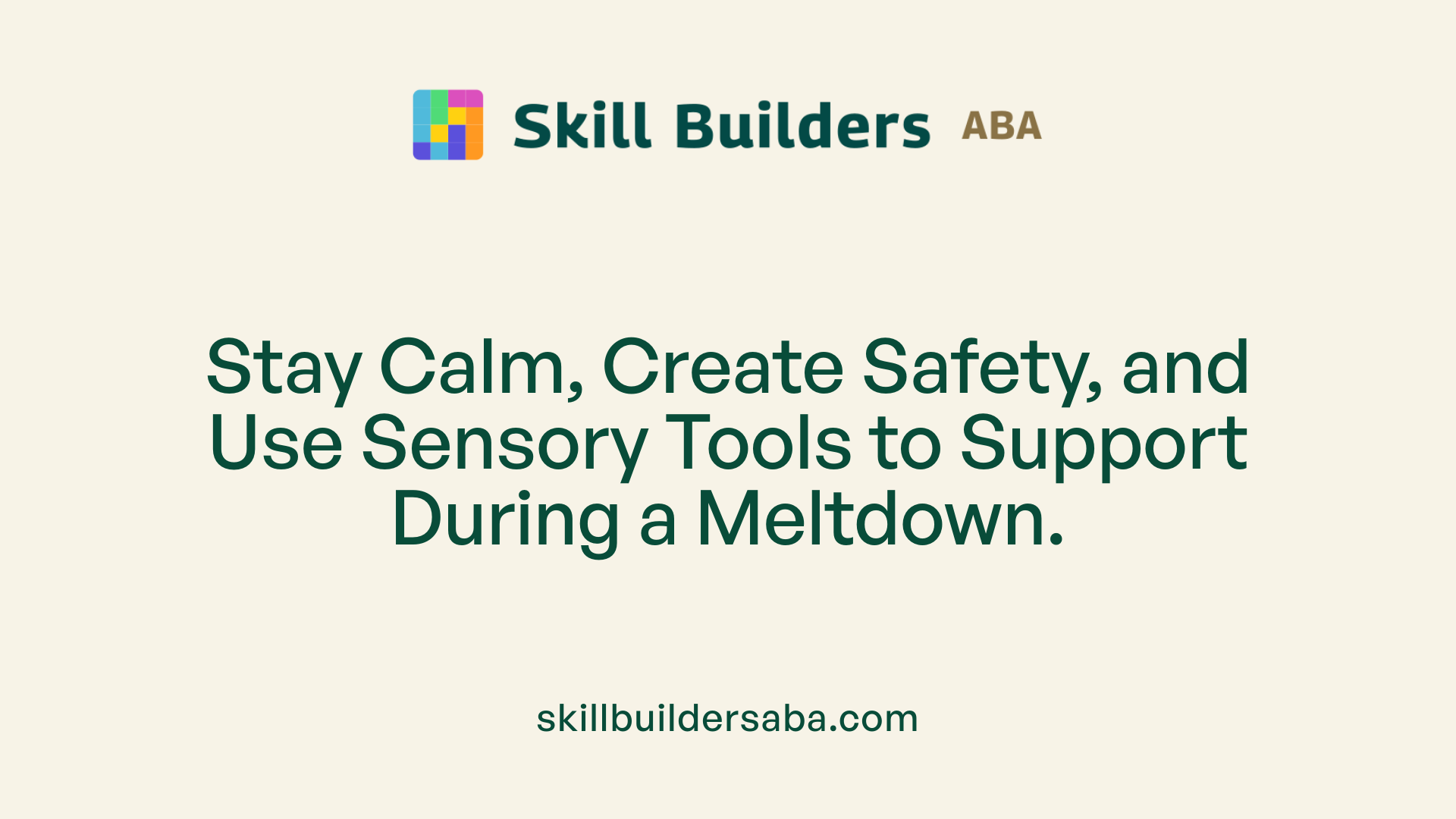
ABA tips for handling public meltdowns
Effective Strategies for Managing Public Meltdowns in Autism
Understanding Autism Meltdowns and Effective Response Strategies
Public meltdowns can be distressing for both children with autism and their caregivers. Recognizing the nature of meltdowns versus tantrums, understanding triggers, and implementing specialized ABA-based techniques can help manage these episodes more effectively. This article explores comprehensive strategies rooted in evidence-based practices to promote safety, reduce occurrence, and support children through their emotional overloads.
Distinguishing Between Autism Meltdowns and Tantrums
What is the difference between autism meltdowns and tantrums?
Autism meltdowns and tantrums are often confused, but they are fundamentally different in cause and behavior. Tantrums are goal-directed behaviors. Children typically use them to communicate needs, express frustration, or obtain something they want. They are deliberate, and children often learn to control or stop tantrums once their goal is met.
In contrast, meltdowns are involuntary responses to sensory overload or emotional chaos. They occur when a child’s nervous system hits a breaking point, making it impossible for them to control their reactions. Unlike tantrums, meltdowns do not stop once a demand is fulfilled.
Tantrums tend to be shorter and manageable, often stopping with consequences or negotiation. Meltdowns are usually more intense, last longer—sometimes 20 minutes or more—and involve overwhelming emotions that the child cannot regulate on their own.
Understanding these differences is crucial for caregivers. While tantrums can be addressed through boundary setting and communication, meltdowns require calming strategies that reduce sensory input and help the child regain control. Recognizing whether a child is having a meltdown or a tantrum directs an appropriate response, fostering safety and emotional support.
Recognizing Early Signs of Public Meltdowns
 Autism meltdowns are often preceded by subtle signs that caregivers and bystanders can learn to identify. Early recognition is crucial for providing support and preventing escalation.
Autism meltdowns are often preceded by subtle signs that caregivers and bystanders can learn to identify. Early recognition is crucial for providing support and preventing escalation.
Physical signs include behaviors such as pacing, hand-flapping, rocking, or restless movements. These may indicate that the individual is becoming overwhelmed by sensory input or emotional stress.
Verbal cues are also important indicators. You might notice increased shouting, crying, or difficulty communicating as the person struggles with their feelings or sensory overload. Sometimes, they may engage in repetitive questioning or become more frustrated.
Behaviorally, signs of an impending meltdown include withdrawal, increased agitation, or repetitive behaviors. The individual may show signs of increasing frustration or lose their ability to mask feelings of overwhelm.
Recognizing these early signs enables caregivers and others to intervene promptly. Strategies might include creating a safe, quiet space, offering calming sensory tools, or using gentle, simple language to help the person regain composure.
Being attentive to these cues can help reduce the intensity and duration of a meltdown, especially in public settings where the environment can be overwhelming. By acting early, you can support the individual's emotional regulation and help them feel safe and understood.
Proactive Prevention Strategies Using ABA Techniques
 Preventing meltdowns before they occur is a crucial part of supporting children with autism. One effective approach involves identifying specific triggers such as sensory overload, routine disruptions, and communication challenges. Recognizing early signs of overstimulation allows caregivers to intervene proactively, reducing the chance of escalation.
Preventing meltdowns before they occur is a crucial part of supporting children with autism. One effective approach involves identifying specific triggers such as sensory overload, routine disruptions, and communication challenges. Recognizing early signs of overstimulation allows caregivers to intervene proactively, reducing the chance of escalation.
Using visual supports and social stories can prepare children for upcoming changes and unfamiliar situations. These tools help in setting clear expectations and creating a predictable environment, which can soothe anxiety and prevent meltdowns. Incorporating practice through role-playing outings at home gradually increases the child’s comfort level, making real-world situations less overwhelming.
Managing sensory input is vital. Personal sensory supports like noise-canceling headphones, sunglasses, or tactile objects can minimize triggers. Teaching calming strategies, such as deep breathing or using preferred calming items, equips children with self-regulation skills that prevent full-blown meltdowns.
Creating consistent routines helps establish a sense of security. When children know what to expect, they are less likely to become overwhelmed. Offering choices within routines—like selecting between two outfits or snacks—can empower children and give them a sense of control.
Practicing transition skills at home is another foundational step. Regularly rehearsing changes in activities, using visual timers or countdowns, helps children understand and adapt to transitions more smoothly. This preparation reduces frustration during real transitions.
During outings or busy environments, caregivers should stay calm, maintain a reassuring presence, and use simple, clear language. Having a contingency plan for early warning signs and implementing calming techniques like sensory breaks or movement activities can help head off crises.
By integrating these ABA-based strategies—such as environmental modifications, visual supports, and teaching coping skills—families and professionals can significantly decrease the likelihood and intensity of meltdowns. Building familiarity, offering predictability, and practicing self-regulation techniques create a safer, more manageable experience for children with autism, enabling them to navigate their world with greater confidence.
Safe and Supportive Responses During a Meltdown
 When a child experiences an autism meltdown, how caregivers respond can greatly influence the duration and intensity of the episode. To help calm a child during a meltdown, staying calm and neutral is essential. A calm demeanor helps communicate safety and reassurance, reducing the child's anxiety and sensory overload.
When a child experiences an autism meltdown, how caregivers respond can greatly influence the duration and intensity of the episode. To help calm a child during a meltdown, staying calm and neutral is essential. A calm demeanor helps communicate safety and reassurance, reducing the child's anxiety and sensory overload.
Creating a safe environment involves removing any dangerous objects nearby and minimizing sensory stimuli that may be overwhelming, such as bright lights or loud noises. Using visual supports, like picture cards indicating calming activities or choices, can provide clear guidance and help the child regain a sense of control.
Calming tools are highly beneficial during a meltdown. Items such as noise-canceling headphones, weighted blankets, or tactile toys can help soothe the nervous system. Providing a quiet space dedicated for regulation allows the child to self-soothe without additional stressors.
Offering physical reassurance through gentle touch or supportive gestures, along with simple, consistent language, helps signal that the caregiver is present and caring. This combination of methods creates an environment conducive to calming down.
Techniques such as deep pressure, calming visuals, and a calm voice are effective. It’s also important to give the child space if they need to retreat. Distraction with their favorite toy or a calming activity can redirect their focus and facilitate emotional regulation.
After the meltdown subsides, it's beneficial to support recovery through reassurance and gentle discussion about what occurred. Recognizing their feelings without shame and teaching coping strategies can set the foundation for better self-regulation in future episodes.
In sum, a calm, safe, and responsive approach not only helps de-escalate meltdowns but also builds trust and emotional resilience for children with autism.
Post-Meltdown Recovery and Reinforcement

What post-incident steps are helpful after a meltdown?
After a meltdown, providing comfort without shame is essential. Children should feel supported and understood, not blamed or embarrassed. Acknowledging their feelings helps them recognize that their emotions are valid and encourages trust.
Reflecting on what triggered the meltdown is an important step. By analyzing the situation, caregivers and professionals can identify specific causes—such as sensory overload, routine changes, or communication difficulties—and use this information to adjust environments or routines, helping to prevent future episodes.
Teaching and reinforcing calming strategies during the recovery phase is vital. Children can learn techniques like deep breathing, sensory tools, or gentle movement to self-regulate. Consistently practicing these approaches helps them build independent self-management skills over time.
Using positive reinforcement rewards successful use of calming techniques. Praising efforts or offering preferred activities encourages children to understand the benefits of self-control and promotes continued practice of calming behaviors.
Maintaining predictable routines and offering reassurance contribute to emotional stability. Clear, consistent schedules help children feel safe and secure, easing the recovery process and reducing anxiety about future transitions or changes.
By combining these strategies, caregivers can support children in recovering from meltdowns more smoothly and foster skills that promote resilience and independence in managing overwhelming situations.
Collaborating with Professionals and Resources for Support
 Working with Applied Behavior Analysis (ABA) therapists is crucial for developing personalized strategies to manage meltdowns effectively. These professionals can conduct comprehensive assessments and tailor intervention plans that address each child's unique triggers and needs.
Working with Applied Behavior Analysis (ABA) therapists is crucial for developing personalized strategies to manage meltdowns effectively. These professionals can conduct comprehensive assessments and tailor intervention plans that address each child's unique triggers and needs.
Conducting a Functional Behavior Assessment (FBA) helps pinpoint the specific reasons behind a child's meltdowns. An FBA explores what the child might be trying to communicate or achieve through their behavior, such as seeking sensory input or avoiding a difficult task. Understanding these functions allows caregivers and professionals to implement targeted strategies that reduce the likelihood of meltdowns.
Utilizing available resources is essential for ongoing support. Parents and caregivers can benefit from support groups, which offer shared experiences and emotional backing. Educational websites and local therapy services often provide training on managing emotional regulation, sensory coping techniques, and creating structured routines. Many online platforms present webinars led by experts, focusing on evidence-based practices like visual supports, sensory tools, and calming routines.
Partnering with educators is also vital to ensure consistent strategies across different environments. Schools and therapists can collaborate to implement visual schedules, prepare children for routine changes, and teach communication skills that lessen frustration.
Here is a summary of supportive resources:
| Resource Type | Description | Benefits |
|---|---|---|
| Support Groups | Community or online groups connecting parents and caregivers | Emotional support, shared experiences |
| Educational Websites | Platforms offering training videos and articles | Learning evidence-based techniques |
| Therapy Services | Occupational and behavioral therapies | Personalized coping strategies |
| Parent Coaching | Professional guidance for managing meltdowns | Customized plans and practical advice |
Learning how to manage meltdowns involves a collaborative approach that integrates therapy, community resources, and educational partnerships. Professionals like ABA therapists can help craft individualized plans, conduct assessments, and support families in implementing proactive and reactive strategies. Utilizing these tools and community resources significantly enhances the ability to support children during overwhelming moments, promoting safety, understanding, and emotional regulation.
For further assistance, searching for 'Resources for autism meltdown management' can connect caregivers with relevant, practical tools and expert advice tailored to their needs.
Empowering Caregivers with Knowledge and Strategies
Understanding the differences between meltdowns and tantrums, recognizing early warning signs, and employing individualized ABA strategies are crucial for effectively managing public meltdowns in children with autism. Through proactive planning, environmental modifications, and emotional support, caregivers can ensure safety and promote emotional regulation. Utilizing professional resources—including ABA therapists, support groups, and educational tools—further enhances the ability to handle these challenging episodes with patience and confidence. Empowered with proper knowledge and personalized techniques, caregivers can reduce the frequency and intensity of meltdowns while fostering resilience and well-being in their children.
References
- Managing Autism Meltdowns at Home: ABA Strategies for ...
- Tips For Handling autism Meltdowns
- Meltdowns & Calming Techniques in Autism
- How to Handle Public Meltdowns with Your Child
- Dealing with Autism Meltdowns: How to Calm an Autistic ...
- The Difference Between Meltdowns & Tantrums
- Tantrum vs Autistic Meltdown: What is the difference? How ...
Reach Out Today
Learn more about how we can support your child’s growth and development. Contact us to discuss our services and availability in your area.
.svg)